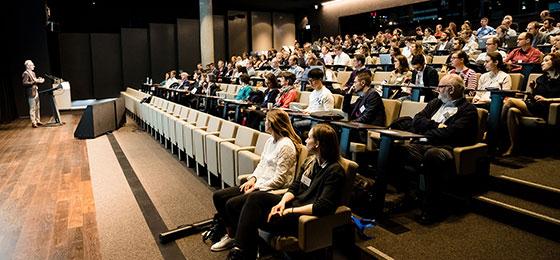Half-time for NRP 72

The National Research Programme "Antimicrobial Resistance" (NRP 72) reached its halfway mark in 2019: the first research results are out, and work on the programme synthesis has already started.
All 45 projects of NRP 72 are going full speed ahead: doctors, vets, biologists and environmental researchers are working together to find solutions to stem the spread of antibiotic resistance and improve treatment options. That said, the projects have staggered start dates and different funding periods. For this reason, part of the research work is already close to completion (as of January 2020), whereas other work will continue until year-end 2021.
Impact beyond academia
Many projects were already able to present their initial results in 2019. Some of them were met with great interest in the academic world and beyond. For instance, the discovery of a new class of antibiotics that are particularly effective against the most dangerous antibiotic-resistant germs. An NRP 72 project based at the Biozentrum of the University of Basel played a leading role in the breakthrough. Another study attracting attention is the so-called "outdoor calf" project, in which veterinarians from the University of Bern were able to show that antibiotics use can be reduced to a fifth of its usual volume with relatively simple methods.
Framing recommendations
Such successes are not only promising scientifically, they also give rise to implementation-related topics. NRP 72 will increasingly focus on the latter aspect as the programme continues on its path. The programme is pursuing two lines of action: on the one hand, individual projects are receiving customised support for knowledge transfers to the practical realm; on the other hand, NRP 72 is preparing a set of recommendations for political actors and experts based on a synopsis of the projects in combination with the latest scientific insights, also from outside NRP 72.
To this end, the Steering Committee and NRP 72 researchers kick-started the programme's synthesis work. At the programme conference, they discussed the main scientific topics, and later on formed three working groups, largely reflecting the NRP's thematic modules. The groups have been tasked with defining and expediting the synthesis process for specific topics.
Focus on implementation in tandem with stakeholder groups
Two of the main topics were already discussed in detail at events held earlier this year, including consultation with stakeholder groups from the political and practical realms. The workshop "Diagnostics in antimicrobial resistance: pathways from basic science to diagnostic laboratories" (held in the context of the programme conference) showed how new tests developed by the researchers can be successfully incorporated into routine diagnostic processes. And the symposium "One Health meets Sequencing" brought together scientists and practitioners from all over Switzerland to discuss the application of new gene analysis methods (whole genome sequencing, or WGS) for public health.
Reaffirming the chosen path
NRP 72 is a highly interdisciplinary undertaking and attaches great importance to the One-Health approach by taking into account human medicine, veterinary medicine and environmental science for the problems posed by antimicrobial resistance. This places high demands on the research plans of individual projects as well as on their implementation. The results of an evaluation study conducted by the University of Bern in early 2019 are therefore all the more gratifying. The study shows that researchers involved in the NRP had a positive opinion of the research work in spite of its challenges, thereby reaffirming the path chosen by NRP 72.
- Report on programme conference 2019 of NRP 72
- Interview Workshop "Diagnostics in Antimicrobial Resistance: Pathways from Basic Science to Diagnostic Laboratories"
- Report on "One Health Meets Sequencing" symposium
- Report on NRP 72 evaluation study" symposium
- Report on "Outdoor calf" project
- News and Interview on new class of antibiotics
